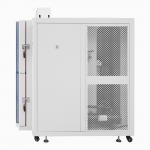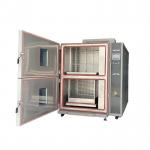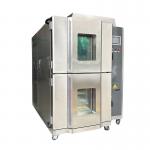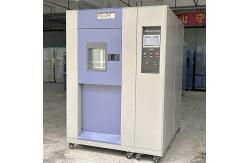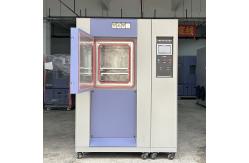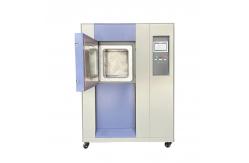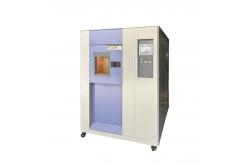In the automotive industry, car tires and rubber seals play vital
roles in ensuring vehicle safety, performance, and comfort. Car
tires endure extreme forces, varying road conditions, and wide -
ranging temperatures during their service life. Rubber seals, on
the other hand, are crucial for maintaining the integrity of
various vehicle components, such as doors, windows, and engine
compartments, by preventing water, dust, and air infiltration. A
custom thermal cycling test chamber is an essential tool for
manufacturers and researchers in this field. It allows for the
simulation of real - world temperature variations that these rubber
- based components encounter, enabling comprehensive testing to
enhance their quality, durability, and reliability. - Wide Temperature Range: The chamber is designed to achieve a broad temperature spectrum,
typically from - 40°C to 150°C. This wide range enables the
simulation of frigid winter conditions, where tires may experience
reduced flexibility and rubber seals may become brittle, as well as
sweltering summer heat, which can cause tires to soften and rubber
seals to degrade due to excessive heat. The ability to precisely
control temperatures within an accuracy of ±1°C ensures that the
test conditions closely replicate the actual environmental
conditions these components face.
- Flexible Cycling Profiles: Users can create highly customizable thermal cycling profiles.
The heating and cooling rates can be adjusted according to specific
test requirements, usually ranging from 1°C/min to 5°C/min.
Additionally, the hold times at different temperature levels can be
defined. For example, when testing car tires, a slow heating rate
might be set to gradually increase the temperature to simulate the
heat build - up during long - distance driving, followed by a rapid
cooling phase to mimic the sudden drop in temperature when the
vehicle is parked in a shaded area.
- Spatial Adaptability: The chamber's interior is designed to accommodate different sizes
and shapes of car tires and rubber seals. For large - sized car
tires, the chamber can be configured with a spacious interior
volume, with customizable dimensions such as length from 0.4 meters
to 2meters, width from 0.4 meters to 2 meters, and height from 0.5
meters to 2 meters. Smaller rubber seals can be tested in batches,
with specially designed holders and fixtures to ensure they are
evenly exposed to the thermal environment.
- Fixturing and Mounting Solutions: To securely hold the tires and rubber seals during testing, the
chamber is equipped with a variety of customizable fixturing and
mounting systems. For car tires, specialized wheel - like fixtures
can be used to hold the tire in a position similar to its on -
vehicle state, allowing for the application of additional forces
such as rotation or compression during the thermal cycling process.
Rubber seals can be mounted on simulated vehicle components, such
as door frames or engine covers, to accurately replicate their real
- world installation and usage scenarios.
- Multi - Parameter Monitoring: A comprehensive monitoring system is integrated into the chamber.
It continuously monitors temperature, as well as other relevant
parameters such as humidity (if required for specific tests), and
can even be equipped to measure physical properties of the
components under test. For example, strain gauges can be attached
to rubber seals to measure their deformation under different
thermal conditions, while pressure sensors can be used to monitor
the airtightness of a sealed compartment with a rubber seal during
the thermal cycling process.
- Real - Time Data Logging: The chamber is equipped with a data - logging system that records
all monitored parameters in real - time. This data can be stored
for later analysis, allowing manufacturers to identify trends,
detect early signs of component degradation, and optimize the
design and manufacturing processes based on the test results. The
data acquisition frequency is adjustable, typically from [Min Freq]
Hz to [Max Freq] Hz, ensuring that even the most rapid changes in
the test parameters are accurately captured.
| Model | JTS-49-3 | JTS-80-3 | JTS-150-3 | JTS-216-3 | JTS-512-3 | JTS-1000-3 | | Inside dimension(W x D x H) cm | 40 x 35 x 35 | 50 x 40 x 40 | 65x 50 x 50 | 60 x 60 x 60 | 80 x 80 x 80 | 100 x 100 x 100 | | Outside dimension(W x D x H)cm | 128x 190 x 167 | 138 x 196 x 172 | 149 x 192 x 200 | 158 x 220 x 195 | 180 x 240 x 210 | 220 x 240x 220 | | Internal material | #304 Stainless Steel | | External material | Powder coated #304 Stainless Steel | | High temperature range | 60 ℃ ~ 200 ℃ | | Low temperature range | 0 ℃ ~ -70 ℃ | | Test temperature range | 60 ℃ ~ 180 ℃ / 0 ℃ ~ -70 ℃ | | Temperature recovery time | 1-5min | | Temperature stability ℃ | ±2 | | Cylinder switching time | 10s | | High temperature ℃ | 150 | 150 | 150 | 150 | 150 | 150 | | Heating time (min) | |
|
